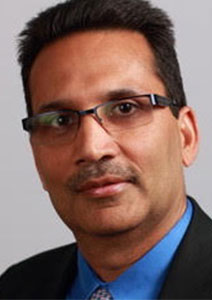Artificial intelligence supercomputer to ‘accelerate research’ at Case Western Reserve University

Computer and data science chair obtains high-powered computer system with support from National Science Foundation, Ohio Department of Education
More than 250 researchers across nearly two dozen research groups—from computer science to materials science to robotics—will benefit from the faster and larger computing power of a new “Artificial Intelligence SuperComputer” (AISC) at Case Western Reserve University.
The nearly $1 million computer system, expected to be installed and in use by summer 2022, is the university’s largest and “far more powerful than anything university researchers had access to before,” said Vipin Chaudhary, the Kevin J. Kranzusch Professor and chair of the Department of Computer and Data Sciences at Case Western Reserve.

That new supercomputing power will eventually will be housed in at least five refrigerator-sized computers in the university’s data center. It is expected to accelerate machine learning and artificial intelligence (AI) tasks by at least 10 times when compared to existing campus systems, Chaudhary said.
The result: More users will be able to manipulate more and larger datasets—and do so simultaneously and much faster.
Chaudhary led the effort to secure external funding for the AISC, including significant support from the National Science Foundation (NSF) and assistance from the Ohio Department of Higher Education Action Fund. The university also contributed to the project.
The new system includes the latest and fastest graphic processing units, higher bandwidth memory, high-speed connections and a key component known as “Non-Volatile Memory Express (NVMe)-based storage.”
NVMe connects the processor to the computer’s “persistent memory” that is both faster and more scalable than existing methods, Chaudhary said. Persistent memory means that data can continue to be quickly accessed even after the process that created or last modified the data has ended.

Alumnus Kranzusch, whose $5 million commitment in 2019 catalyzed the creation of the department, applauded the news.
“Congratulations to the entire university community, especially the students, for gaining access to such a powerful tool to explore the uses of AI and High Performance Computing in their fields,” said Kranzusch, a vice president of NVIDIA, the company that invented the GPU (Graphics Processing Unit). “I am certain that the collaboration and rigor that CWRU is known for will only be enhanced with the addition of this important asset.”
Boosting existing research
As part of his NSF proposal, Chaudhary surveyed dozens of Case Western Reserve faculty, postdoctoral researchers, PhD students and graduate and undergraduate students. He asked about their computer-research needs and their wishes for deeper study.
Those researchers said they needed more computing power for topics ranging from photovoltaic research to financial fraud protection and cybersecurity. Others would use enhanced computing power to perform simulations of the universe, map the brain in unique ways and improve disease analysis and prediction.
“To solve large problems and to create solutions that will have an impact, you have to have the infrastructure to do the work,” Chaudhary said. “I believe this will boost a lot of ongoing research and enable a lot of new work.”
The first people to be able to access the new computer will be the 250 users he included in the original NSF grant proposal.
 Venkataramanan “Ragu” Balakrishnan, the Charles H. Phipps Dean of the Case School of Engineering
Venkataramanan “Ragu” Balakrishnan, the Charles H. Phipps Dean of the Case School of Engineering
That said, any university faculty member also will be able to request access through an online form that asks for a description of the proposed research and expected use requirements.
This new acquisition will give “researchers the power to explore further and faster than ever before, and will prove catalytic in advancing breakthroughs in disciplines across the university,” said Venkataramanan “Ragu” Balakrishnan, the Charles H. Phipps Dean of the Case School of Engineering. “From advancing cancer detection to analyzing the deterioration of nuclear materials, artificial intelligence and supercomputing are at the core of our most innovative initiatives.”
Focus on advanced computing power
Chaudhary came to Case Western Reserve in 2020 as the inaugural chair of the new department. This fall, Kranzusch doubled his commitment to the department with a second $5 million gift.
Previously, Chaudhary had been program director for the NSF’s Directorate for Computer and Information Science and Engineering in the Office of Advanced CyberInfrastructure.
He said one of his main goals was to bring advanced computing power to the School of Engineering and across the CWRU campus.
Chaudhary is also one of the leaders of a new $20 million Artificial Intelligence institute at Ohio State University (OSU) as part of an expansive federal initiative to bring the power of AI to more Americans.
Case Western Reserve is partnering with OSU, Indiana University and a dozen other universities to work toward building the next generation of cyberinfrastructure necessary to bring AI to more people, in this case farmers and wildlife managers, especially.
The institute is part of a larger, $220 million NSF initiative announced in August that funds 11 institutes nationwide.
For more information, contact Mike Scott at mike.scott@case.edu.
This article was originally published Dec. 6, 2021.

